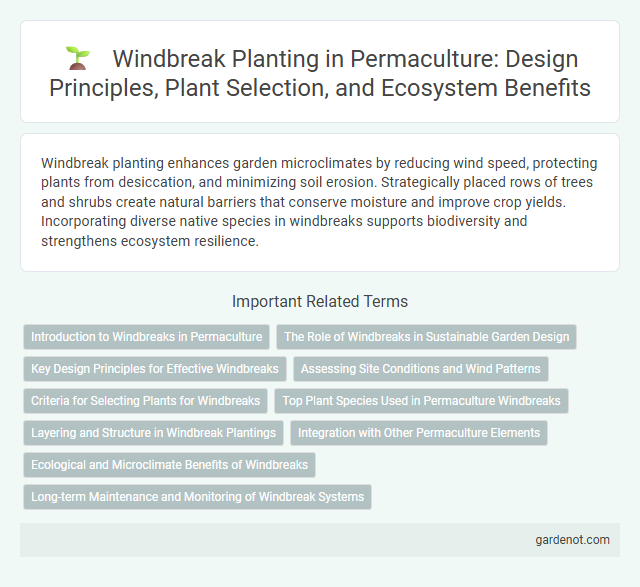Windbreak planting enhances garden microclimates by reducing wind speed, protecting plants from desiccation, and minimizing soil erosion. Strategically placed rows of trees and shrubs create natural barriers that conserve moisture and improve crop yields. Incorporating diverse native species in windbreaks supports biodiversity and strengthens ecosystem resilience.
Introduction to Windbreaks in Permaculture
Windbreak planting in permaculture involves strategically placing rows of trees or shrubs to reduce wind speed and protect crops, soil, and structures from wind damage. These living barriers enhance microclimates by conserving moisture, reducing erosion, and creating habitats for beneficial wildlife. Effective windbreaks improve agricultural productivity while promoting biodiversity and ecosystem resilience.
The Role of Windbreaks in Sustainable Garden Design
Windbreak planting enhances sustainable garden design by reducing wind erosion and protecting soil moisture, which supports healthy plant growth and biodiversity. Strategically placed rows of trees or shrubs create microclimates that improve energy efficiency and minimize stress on garden plants. Incorporating native species in windbreaks promotes ecosystem balance and resilience against weather extremes.
Key Design Principles for Effective Windbreaks
Windbreak planting in permaculture prioritizes strategic placement of multipurpose vegetation to reduce wind speed, protect soil, and enhance microclimates. Key design principles include selecting diverse native plant species with varying heights and densities to create layered barriers that maximize wind attenuation. Proper orientation perpendicular to prevailing winds ensures optimal protection for crops, structures, and livestock, while integrating nitrogen-fixing and habitat-supporting plants promotes ecosystem health and resilience.
Assessing Site Conditions and Wind Patterns
Assessing site conditions and wind patterns is crucial for effective windbreak planting in permaculture. Analyze prevailing wind directions, seasonal shifts, and wind speed using local weather data and physical observations to determine optimal windbreak placement. Soil type, topography, and existing vegetation must be evaluated to select appropriate plant species that enhance microclimates and maximize wind protection.
Criteria for Selecting Plants for Windbreaks
Effective windbreak planting requires selecting species based on height, density, and root structure to ensure optimal wind reduction and soil stabilization. Plants should possess deep root systems for erosion control and be adapted to local climate conditions to maximize survival and growth. Native or well-established species are preferred for their ecological benefits and compatibility with surrounding biodiversity.
Top Plant Species Used in Permaculture Windbreaks
Top plant species used in permaculture windbreaks include nitrogen-fixing trees like Acacia and Albizia, which enhance soil fertility while providing wind protection. Fast-growing shrubs such as Sea Buckthorn and Elaeagnus offer dense foliage to reduce wind speed and prevent soil erosion. Diverse layers of plants combining native grasses, evergreen trees like Cypress, and fruit-bearing species like Mulberry create multi-functional, resilient windbreak systems.
Layering and Structure in Windbreak Plantings
Windbreak planting relies on strategic layering and structure to maximize protection against wind erosion and improve microclimates for crops. Typically, windbreaks consist of multiple rows with a mix of tall, medium, and low-height species arranged to create a dense barrier that reduces wind speed effectively. Incorporating diverse plant layers--from canopy trees to shrubs and ground covers--enhances biodiversity, soil stability, and overall ecosystem resilience within permaculture systems.
Integration with Other Permaculture Elements
Windbreak planting enhances microclimates by reducing wind speed, which supports the growth of nearby orchard trees, vegetable gardens, and herb spirals. Strategic placement of windbreaks integrates water catchment systems and composting zones, improving soil moisture retention and nutrient cycling. This synergistic design maximizes ecosystem resilience and productivity within permaculture setups.
Ecological and Microclimate Benefits of Windbreaks
Windbreak planting enhances ecological balance by reducing soil erosion, increasing biodiversity, and providing habitats for beneficial insects and birds. These living barriers create microclimates that moderate temperature extremes, reduce wind speed, and increase humidity, promoting healthier plant growth and improved crop yields. Effective windbreaks also conserve soil moisture and protect against frost, contributing to sustainable land management in permaculture systems.
Long-term Maintenance and Monitoring of Windbreak Systems
Long-term maintenance of windbreak planting involves regular inspections to assess tree health, pest infestations, and structural integrity, ensuring optimal performance in protecting crops and soil. Monitoring growth rates and replacing any damaged or dead plants preserves windbreak density and effectiveness over time. Implementing adaptive management strategies based on seasonal weather patterns and ecological changes supports sustainable windbreak resilience and longevity.
Windbreak planting Infographic

 gardenot.com
gardenot.com